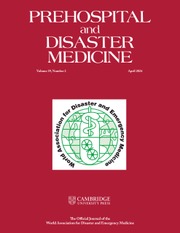No CrossRef data available.
Article contents
Assessing the Predictive Value of mREMS in Patients with Trauma from the Syrian Civil War: A Retrospective Epidemiological Study
Published online by Cambridge University Press: 07 October 2025
Abstract
The Syrian Civil War (SCW) began in 2011 and has resulted in numerous cases of war-related civilian injuries. The modified Rapid Emergency Medicine Score (mREMS) is widely used as an effective tool for assessing clinical status and mortality risk, particularly in intensive care units (ICUs) and emergency departments (EDs). However, to date, no study has evaluated the ability of mREMS to predict mortality in patients injured during the SCW.
The primary objective of this study was to evaluate the performance of mREMS in predicting in-hospital mortality among adult trauma patients injured during the SCW. The secondary objective was to analyze the epidemiological characteristics of both adult and pediatric populations affected by the SCW.
This single-center, retrospective observational study included patients who were injured during the SCW and presented to the ED from January 2012 through January 2016. Data from 4,074 adult patients and 1,379 pediatric patients were analyzed. The diagnostic and prognostic performance of the mREMS was specifically assessed in the adult cohort. Additionally, an epidemiological evaluation of the demographic and clinical characteristics of both cohorts was conducted.
Among the 4,074 adult patients included in the study, a total of 3,657 (89.8%) were male and 417 (10.2%) were female. In-hospital mortality occurred in 484 patients (11.9%). Adult patients admitted to the ICU exhibited a mortality rate 7.6-times higher than those who were not admitted (odds ratio [OR] = 7.6; 95% confidence interval [CI], 6.2–9.3). The analysis of the mREMS revealed a median score of eight for survivors and fourteen for non-survivors, demonstrating a statistically significant difference (P < .001).
The present study demonstrated that the majority of civilians injured during the SCW were young males. Furthermore, this study’s findings indicated that the mREMS exhibits excellent performance in predicting in-hospital mortality among trauma patients injured during the SCW.
Information
- Type
- Original Research
- Information
- Copyright
- © The Author(s), 2025. Published by Cambridge University Press on behalf of World Association for Disaster and Emergency Medicine


